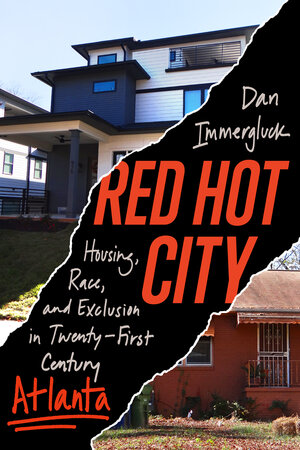By Dan Immergluck, author of Red Hot City: Housing, Race, and Exclusion in Twenty-First-Century Atlanta
Rising home prices and rents are on everyone’s mind these days. In the wake of COVID-19, housing costs rose rapidly in most cities. Yet the U.S. housing crisis is not new, and has been worsening since the country came out of the foreclosure crisis around 2012. Over the last decade, rent soared in many cities, including in growing regions like the Sunbelt. Formerly “low-cost” cities like Atlanta, Nashville, Raleigh, and many others have seen strong housing market pressures in their urban cores, resulting in a new era of gentrification that Derek Hyra and others have called “fifth-wave” gentrification.
In my new book, Red Hot City: Housing, Race, and Exclusion in Twenty-First Century Atlanta, Atlanta serves as a paradigmatic case of the booming Sunbelt metro with strong gentrification pressures in the central city and increasing racial diversity in the suburbs. I wrote the book because I had studied and witnessed the growth and change of the city and its suburbs since the mid-2000s, and was frustrated at the resulting patterns of exclusion and inequality.
As the real estate market in the city came roaring back after 2011, I noticed an acceleration of trends that had slowly begun about 15 years earlier around the 1996 Olympics. Similar to what had happened with the Olympics and the public housing demolitions that followed, I saw a series of policy and planning decisions that favored, supported, and subsidized gentrification in the city and exclusion in affluent suburbs. While these decisions were not surprising, they were not inevitable. Local and state leaders could have made different choices to support equitable outcomes.
There were key inflection points where policymakers could have anticipated and steered development to mitigate displacement and other harms of gentrification. For example, through fairer property tax policies, they could have captured a much greater share of the accompanying land value growth and used these resources to provide affordable housing programs for low-income families. In higher-income suburbs, localized suburban growth machines — with the support of affluent homeowners— worked on “place-making” projects and suburban “retrofits” that resulted in the demolition of older, lower-cost apartments, displacing and scattering their lower-income tenants, and replacing them with “live-work-play” spaces aimed at much more affluent residents.
Atlanta, and growing metros like it, have become the political battlegrounds of the twenty-first century. In the fall of 2022, many eyes will fall on Atlanta: a key Senate seat is on the line again, and Stacey Abrams —perhaps the highest profile Democratic gubernatorial candidate — is challenging a traditional southern conservative. The metro is now minority-white, and Black, Latinx, and Asian households have comprised 80 percent of the region’s growth since 2000. While some point to California when they discuss the future political demography of metropolitan America, Atlanta provides a better glimpse of the future, especially for Sunbelt metros. These metros, on the whole, are increasingly racially diverse, but suffer from persistent and growing forces that work to segregate their residents by income and wealth. They are often located in states with conservative state legislatures that hamstring efforts to create more equitable housing and development policies, including stronger tenants’ rights, rent stabilization, and funding for affordable housing.
It is my hope that Red Hot City provides readers with a stronger appreciation for the struggles that these key metros face over the next few decades. Moreover, the book should serve as a warning to other cities and a plea for making different choices before it is too late.
This post is part of our #ASA2022 blog series. During the conference, get 40% off the book with code 22E7905.
